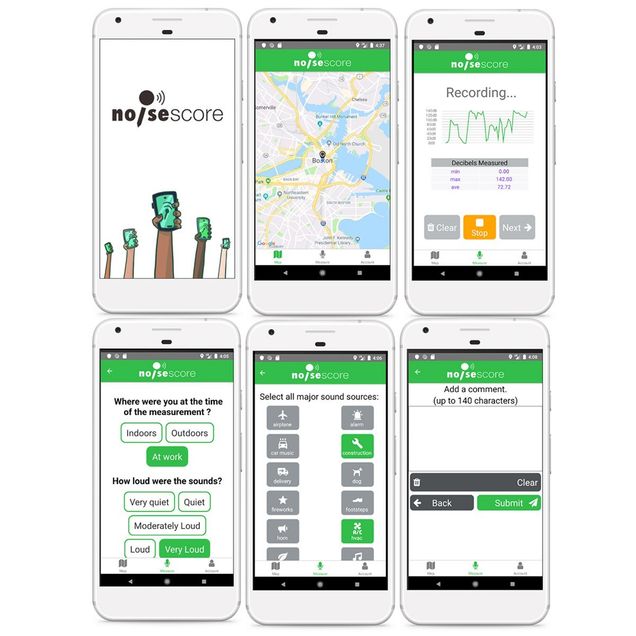Noise on the Map: Using NoiseScore to Address Community Noise Issues
The Software & Application Innovation Lab (SAIL) at the Hariri Institute for Computing works with researchers across Boston University to develop and incorporate computational tools that advance data-driven research. This summer, the SAIL team deployed NoiseScore 2.0, a mobile application that allows community residents to document and visualize their ever-changing environmental soundscape. This project is in collaboration with PI Erica Walker, a postdoctoral researcher and founder of Community Noise Lab at the Boston University School of Public Health. Dr. Walker is an environmental epidemiologist and exposure scientist interested in understanding how sound and noise impact community health and well-being. Read more about how Dr. Walker is leveraging data storytelling and computational tools for public health research.
The Hariri Institute is excited to host Dr. Walker, community members, and potential NoiseScore users at the upcoming community event on Thursday, September 26th
Tell us about your background and your current research interests.
I have had the privilege of wearing many hats over the years! My academic background is in mathematics, economics, urban planning, and environmental health. I have taught high school students, struggled through (and then dropped out of) a year of architecture school, made furniture, bound books, started and ran a business, dissected the inner ears of lab mice, and these days, am raising a growing family of strange cacti of all shapes and sizes. To some, these varied experiences may signal a chaotic mind, but to me, they have rather brilliantly informed my current research interests, which are to work with communities of all varieties to understand their unique sound and noise issues and its impacts on their health.

What inspired you to start the Community Noise Lab?
Community Noise Lab was birthed from a very real iterative process, ignited by a noise spat with some very loud upstairs neighbors. From this traumatic experience, I went through all the stages of grief: denial, anger, bargaining, depression, and acceptance (because I ended up moving). But I also learned a great deal through each stage: that community noise issues are much bigger than myself, that these issues are impacting our mental and physical health, and that we, as researchers, can more deeply and creatively drive the conversation about how sound and noise issues can impact our health. So, Community Noise Lab is me refusing to accept that last stage of grief and instead, deciding to move towards ACTION. I want to work with communities to examine their unique noise issues using real-time monitoring, citizen engagement tools, like our NoiseScore app, laboratory-based experiments, and community engagement activities.
How do you leverage data storytelling and computational tools in your work?
In the realm of sound and noise research, I consider data storytelling and computational tools as both currency and vehicles for democracy. Sound level data has traditionally only been available to entities that can afford to have it collected on their behalf. As a result, these gatekeepers are the drivers of the conversation around sound and noise issues. This makes me really uncomfortable. Community Noise Lab will leverage these data to give communities more skin in the game—a seat at the table AND a voice in the discussion. I view these data and tools as vehicles for community-based brainstorming, question generation, and directions for advocacy. Currently, these data have been (or will be) used for legislative testimony and good neighbor agreements. Generally speaking, I hope it helps us disrupt the status quo where noise pollution is concerned. I am devoted to keeping our work open-sourced (boston.noiseandthecity.org) and will make all data, reports, maps, and other materials available to view or download via our Community Noise Library.
 How has your engagement with communities impacted how you do your research?
How has your engagement with communities impacted how you do your research?
Because noise is defined as unwanted sound, noise research cannot exist without community engagement. Working with various communities has made me a more textured researcher. For starters, there are a bunch of real-life people to hold you accountable for what you say you will do. They have your phone number or email and have no qualms about calling you out if you fall short! As a result of my community engagement, I get to travel to places I might otherwise not go, I get to have conversations with people I might not otherwise talk to, I get to think about things I otherwise might not have thought of, I get to confront and address my shortcomings and failures, and I get to impact change. All of this happens in real-time around very real problems like live concerts, construction, aircraft, and highway noise.
Looking ahead, how do you plan to expand the scope of your current research?
I would like to expand into other communities of various flavors, incorporate indoor noise exposure, add a few more bells and whistles to the NoiseScore app, and continue to use the data collected to construct novel noise metrics that may better describe the environmental soundscape and its impacts on our health.
